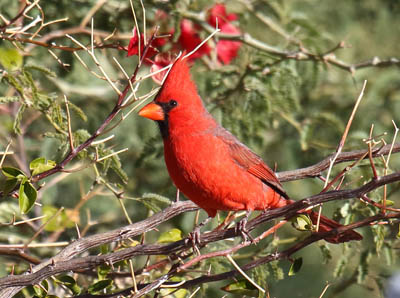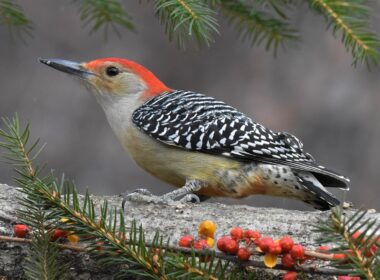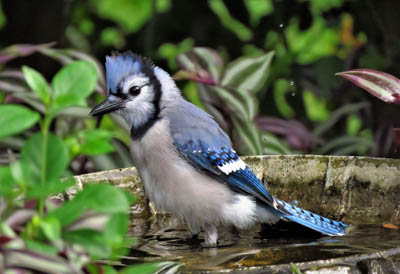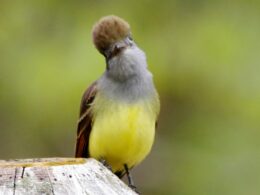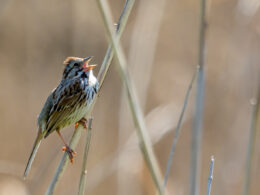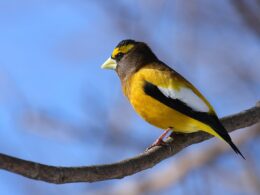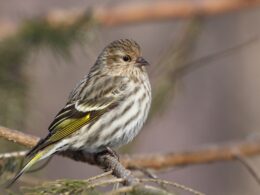Last Updated on January 19, 2024 by Greg Gillson
Did you see a brightly-colored red bird, orange bird, or yellow bird in North Carolina and wonder what is was?
This page is for you!
This article shows you photos and identification of some of the most common birds in North Carolina based on color.
The list of birds found in North Carolina includes over 485 species. So, I can’t show you all of them. I’m going to assume that you saw a common bird of this color, but you certainly could have seen something less common, or even rare!
Shape (including the shape of the bill) and size are often more helpful in starting to identify a bird than the color. In fact, most birds in North American can be easily identified with a black-and-white photo!
Many birds are multi-colored, so that it may be hard to pick out a dominant color. Males and females may be colored quite differently. And some color patterns are similar among otherwise dissimilar species.
Nevertheless, I’m going to try to pick out some of the birds that you are most likely to see in backyards or towns. And I’ll show a few others that I get asked about a lot.
The birds with a noticeable amount of red on them in North Carolina covered in this article are:
- Northern Cardinal
- American Robin
- House Finch
- Ruby-throated Hummingbird
- Summer Tanager
- Red-headed Woodpecker
- Scarlet Tanager
- Ruddy Duck
The birds with a noticeable amount of orange on them in North Carolina covered in this article are:
- Eastern Towhee
- Brown Thrasher
- Red-shouldered Hawk
- Barn Swallow
- Wood Thrush
- American Redstart
- Red-breasted Nuthatch
- Orchard Oriole
The birds with a noticeable amount of yellow on them, including lots of yellow and black birds, in North Carolina covered in this article are:
- American Goldfinch
- Yellow-rumped Warbler
- Pine Warbler
- Northern Flicker
- Common Yellowthroat
- Great Crested Flycatcher
- Northern Parula
- Cedar Waxwing
- Eastern Meadowlark
- Pine Siskin
- Hooded Warbler
- Yellow-throated Warbler
Red birds of North Carolina
Birds get the red, orange, and yellow in their feathers from carotenoids in the fruit, seeds, and plants they eat (source).
These carotenoid colors combine with melanin to form an infinite range of red feathers–pink, rusty, scarlet, violet, red-orange.
The following are red birds that you are most likely to see in North Carolina.
Northern Cardinal
These are one of the most common backyard birds in the eastern United States. Their bright red color and unique head profile makes them instantly identifiable to most people–whether they are bird watchers or not!
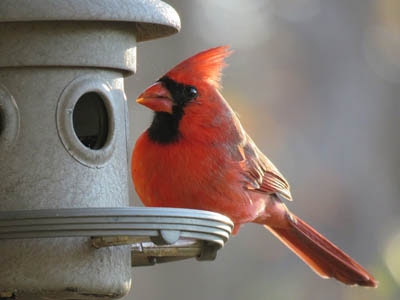 |
| Northern Cardinal. GeorgeB2 from Pixabay. |
Males of these large seed eaters are bright red with a black face and red crest.
Females replace most of the red with brown, The bill is large and orange.
These birds are found in woodlands, stream edges, residential areas.
Northern Cardinals year-round residents throughout North Carolina.
American Robin
These are familiar lawn birds with red breasts.
 |
| American Robin. Greg Gillson. |
Male American Robins are brownish-gray above with a brick red breast. Females are paler orange below and paler gray above.
They are widespread in open country with scattered deciduous trees, residential areas.
American Robins are year-round residents throughout North Carolina.
House Finch
When people ask about a bird with a red head at their feeder, it is usually this bird.
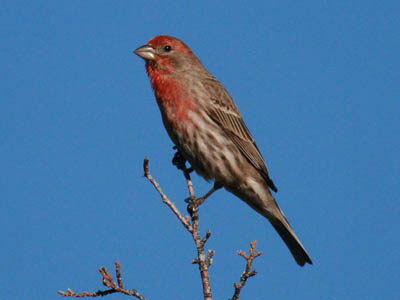 |
| Male House Finch. Greg Gillson. |
Males of this dusty brown striped finch have red limited to the head (specifically the forehead and eyebrow), breast (chest), and rump. The red coloration tends toward orangish, and may rarely be yellowish.
Females are streaked, similar to the males but without red. They lack any strong pattern on the face and head.
Note the small round head and curved upper ridge on the bill.
Some people call these red-headed sparrows. Sparrows and finches are similar, but in general, male finches are brighter than the females and tend to hang out more in trees. Sparrow genders are usually quite similar in coloration and tend to feed mostly on the ground.
These birds are common in residential areas, especially at bird feeders. In the West more widespread in arid regions near water.
House Finches are year-round residents throughout North Carolina.
Ruby-throated Hummingbird
These red-throated birds are the only hummingbird nesting in the eastern United States.
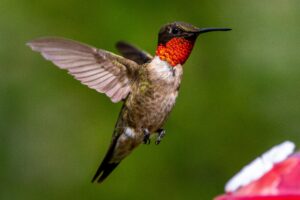
Males are dark green above and on the belly. They have a white upper chest. The throat is ruby-red.
Females are green above, white below, including white throat.
These birds are found in woodland edges, residential yards. Readily come to hummingbird feeders.
Ruby-throated Hummingbirds are summer residents throughout North Carolina.
Summer Tanager
These bright red birds are found toward the tops of tall trees in the southern United States.
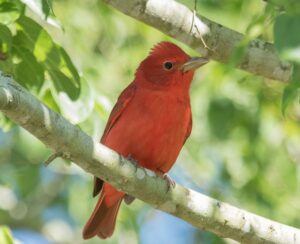
Males are rose red with fairly heavy bill.
Females are yellowish or mustard-colored, some with a faint reddish wash.
In the East these birds are found in pine-oak woodlands. In the West they prefer tall cottonwood trees.
Summer Tanagers are summer residents throughout North Carolina.
Red-headed Woodpecker
These well-known woodpeckers with red heads have a fitting name.
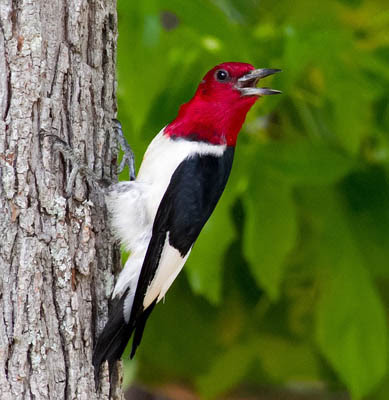 |
| Red-headed Woodpecker. Public domain. |
These birds have the entire head bright deep red. Back and tail black. Underparts white, as are inner secondaries and rump.
They are found in a variety of wooded habitats. They prefer to have oak and beech trees available. Sometimes come to feeders in winter.
Red-headed Woodpeckers are year-round residents throughout most of North Carolina, absent in extreme western North Carolina.
Scarlet Tanager
A brilliant red and black bird!
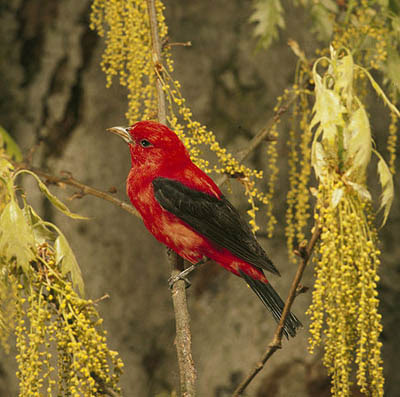 |
| Male Scarlet Tanager. USF&WS. Public Domain. |
Males are unmistakable with brilliant red with black wings and tail.
Females are olive-green above, darker wings and tail, yellower under parts. Pale bill.
These birds live in deciduous woods.
Scarlet Tanagers are summer residents throughout most of North Carolina, spring and fall migrants only in eastern North Carolina.
Ruddy Duck
These small ducks are dark chestnut-red in spring.
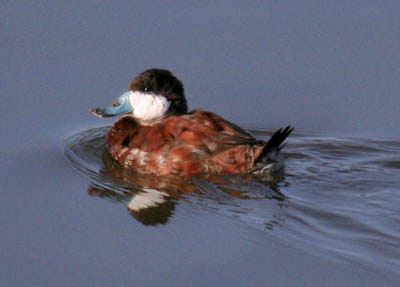 |
| Ruddy Duck. Greg Gillson. |
Males in breeding plumage (late winter and spring) are rusty, with a white face, and a blue bill. The long tail is often held sticking up. In winter they are brown, with white face, and dark bill.
Females all year are like winter males. Brown body, dark cap, dark line through eye of pale face. Dark bill.
These birds prefer weedy ponds to breed, but in winter may be found in deeper ponds in city parks.
Ruddy Ducks are winter visitors throughout North Carolina.
Orange birds of North Carolina
True orange-colored birds are not that common. Many birds that I have here are paler rusty.
The common pattern is an orange body and black or brown wings and tail. Another common pattern is for the orange to be restricted to the under parts.
The following are orange birds that you are most likely to see in North Carolina.
Eastern Towhee
These birds with rusty-orange sides like to hide in dense bushes.
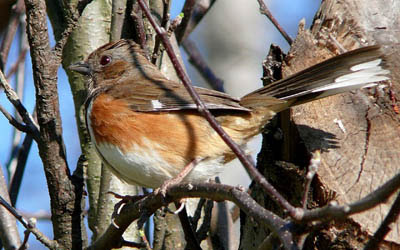 |
| Female Eastern Towhee. Skeeze. Pixabay. |
Males are black above with white wing patch, white tail corners. The sides are rusty. The belly white. Eyes variable: brown, red, orange, white, tending toward whiter southward.
Females are similar, but upper parts brown.
These birds are found in forest understory, dense brush, backyard hedges. Come to feeders.
Eastern Towhees are year-round residents throughout most of North Carolina, summer residents only in western North Carolina.
Brown Thrasher
These are rather large rusty-orange songbirds.
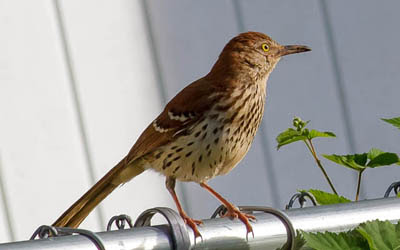 |
| Brown Thrasher. Linda Jones CC0. |
The upper parts of these birds is colored rusty-brown to orange. They show two white wing bars. Under parts are buff with heavy reddish-brown streaking.
These birds live in woodland edges and mature backyard landscaping.
Brown Thrashers are summer residents throughout most of North Carolina, year-round residents in southeastern North Carolina.
Red-shouldered Hawk
Okay, the shoulders are reddish. But the rusty-orange breast and wing linings are barred red too.
 |
| Red-shouldered Hawk. Greg Gillson. |
The upper parts are barred black and white. The tail is banded black and white. In adults the breast is barred orange.
Immature birds are streaked with brown on the breast.
These birds like woodland edges, residential edges, riparian groves.
Red-shouldered Hawks are year-round residents throughout North Carolina.
Barn Swallow
These orange-bellied birds are a familiar sight across North America in summer.
 |
| Barn Swallow. Greg Gillson. |
These birds are purple-blue above with orange under parts and long forked tails. The color of the underparts in winter or on females are often cinnamon or buff-colored, but breeding males can be brighter orange-red.
These birds swoop low over fields and wetlands at lower elevations. They may build their mud nests in rafters on porches, garages, or other out-buildings.
Barn Swallows are summer residents throughout North Carolina.
Wood Thrush
These spotted birds with the orange-brown upper parts tend to hide in understory trees and on the forest floor.
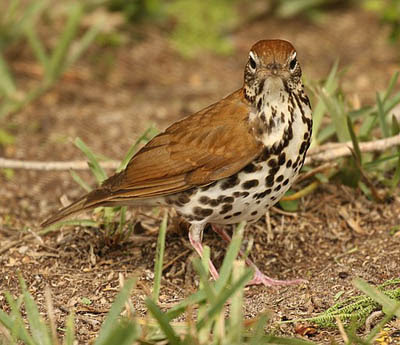 |
| Wood Thrush. Tony Castro. CC BY-SA 4.0 |
These birds are reddish brown on the upper parts, especially rusty orange on the crown and upper back. White eye ring. Large heavy black spots on the under parts.
They live in deciduous and mixed woods. Spend much time on the ground, shuffling through the leaf litter.
Wood Thrushes are summer residents throughout North Carolina.
American Redstart
In flight these small warblers flash orange or yellow in the wing and base of the tail.
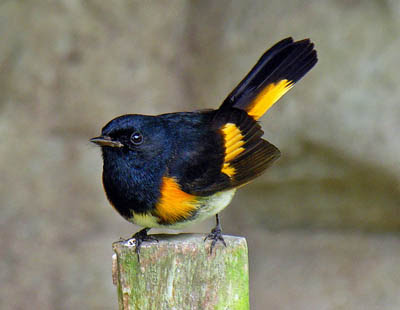 |
| American Redstart. Dennis Jarvis. Flikr. CC BY-SA 2.0 |
Males are black above, white on the belly. They have bright orange patches on side of breast, wings, and base of the tail.
Females are grayer, especially on the head. The orange of males is replaced by yellow on the females.
These birds are found in regenerating woods after a clear cut, and willow tangles along streams.
American Redstarts are summer residents in northern and western North Carolina, spring and fall migrants only in eastern and southern North Carolina.
Red-breasted Nuthatch
These active little red-breasted birds crawls all around on the trunk and big branches of conifers. They search crevices in the bark for insect food.
 |
| Red-breasted Nuthatch. Greg Gillson. |
These tiny birds have blue-gray backs and a black line through a white face. Some males can have quite bright rusty red under parts. Some females can have quite pale buff-colored under parts. Most birds show an orange-cinnamon breast color.
Found nearly exclusively in conifers. Readily come to feeders.
Red-breasted Nuthatches are winter visitors throughout North Carolina, year-round residents in mountains of western North Carolina.
Orchard Oriole
Males of these orioles are darker rustier-orange than most other orioles in the United States.
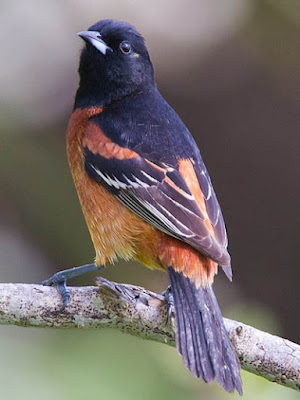 |
| Orchard Oriole. Dan Pancamo. Flikr. CC BY-SA 2.0 |
Males have a black hood and back, black wings and tail. The under parts are rusty-orange or even chestnut-brown.
Females are greenish above, lemon yellow below. They have 2 thin white wing bars. The bill is thinner than many other orioles.
They are found in orchards and residential shade trees.
Orchard Orioles are summer residents throughout North Carolina.
Yellow birds of North Carolina
Yellow is a common bird color! Often it is mixed with black and white plumage in birds.
Many birds with darker upper parts have yellow breast or belly.
The following are yellow birds you are most likely to see in North Carolina.
American Goldfinch
These small little birds are bright yellow and black.
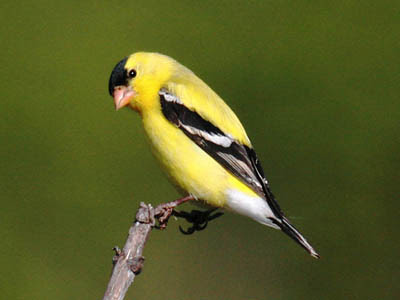 |
| American Goldfinch. Greg Gillson. |
Males are bright lemon yellow with black and white wings and tail, black cap. White under tail coverts. Pink bill.
Females are duller yellow below and brownish above. Lack black cap.
Winter birds are pale brown or gray, a touch of yellow on the throat of males.
These are birds of open country, fields with saplings, clear cuts, residential areas. They avoid dense forests, mountains, deserts. They visit feeders.
American Goldfinches are year-round residents through most of North Carolina, winter visitors only in southeastern North Carolina.
Yellow-rumped Warbler
These are abundant warblers across North America. Affectionately called “butter butts” by many birders, because of their bright yellow rumps that flash in flight.
 |
| Breeding Yellow-rumped (Myrtle) Warbler. Greg Gillson. |
Western form (Audubon’s) with bright yellow throat and yellow rump. Large white wing patch.
Northern and Eastern form (Myrtle) with white throat, yellow rump, and two white wing bars.
Winter birds are dull gray brown, with bright yellow rump. Throat may be cream colored or white. Often difficult to tell the two forms apart in winter.
 |
| Winter Yellow-rumped Warbler. Greg Gillson. |
Breed in mountain or boreal conifers. Widespread in migration. Winter in low river bottoms, open weedy deciduous areas. Rarely come to feeders in winter.
Yellow-rumped Warblers are winter visitors throughout most of North Carolina.
Pine Warbler
This yellow and gray bird is one of the few warblers to visit feeders–and the only one to eat seeds!
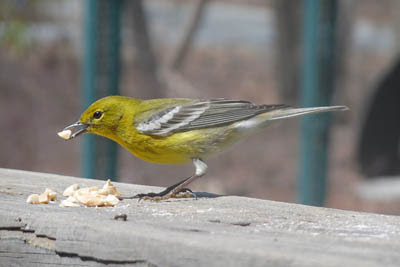 |
| Pine Warbler. Nikolaus Schultz. Pixabay. |
These birds are yellow-green on head, back, and breast. Wings blue-gray with wide white wing bars. Yellow split eye ring.
Strongly associated with pine forests. Usually high in tree tops.
Pine Warblers are year-round residents throughout most of North Carolina, summer residents only in mountains of western North Carolina.
Northern Flicker
These woodpeckers spend much time eating ants on the ground.
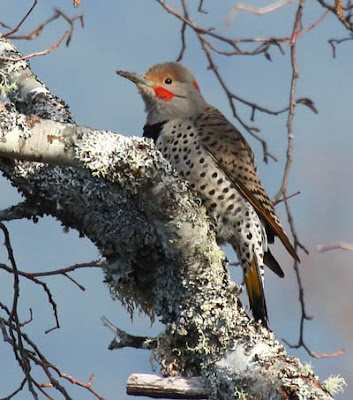 |
| Northern Flicker. Greg Gillson. |
These birds are larger than robins with brown and black barred upper parts. The underparts are pink with round black spots. There is a black crescent across the chest. When they fly away from you they reveal a large white rump.
Western birds have salmon-red under wings and under tail. Those in the East are colored yellow. The male face differs between the two populations–black whisker on the eastern birds, red whisker on western birds. Intergrades from overlap on Great Plains common. These may show male facial characteristics of both populations, or yellow-orange flight feathers.
These birds live in open woods with bare ground for foraging, residential yards.
Northern Flickers are year-round residents throughout North Carolina.
Common Yellowthroat
These buttery yellow birds are abundant in the marsh vegetation.
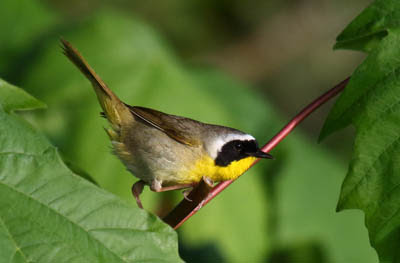 |
| Male Common Yellowthroat. Greg Gillson. |
These skulkers have bright yellow throats and yellow undertail coverts. Males have a black domino mask edged broadly in white, which females lack. Upperparts are dull olive-green.
Immature males in fall show a shadowed black mask.
Found in damp situations and heavy deciduous brambles following clear cuts.
Common Yellowthroats are summer residents throughout most of North Carolina, year-round residents in eastern North Carolina.
Great Crested Flycatcher
These flycatchers have long tails and big heads with big bill and bright yellow belly.
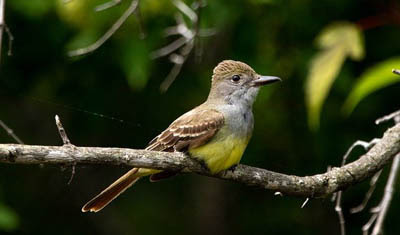 |
| Great Crested Flycatcher. Simard Francois. Pixabay. |
These birds are gray on the face and breast, brownish on rest of upper parts. Bright lemon yellow belly. The under side of the tail and some feathers of the wing are cinnamon colored.
These birds stay in the canopy of open woods.
Great Crested Flycatchers are summer residents throughout North Carolina.
Northern Parula
This is a handsome blue and yellow warbler.
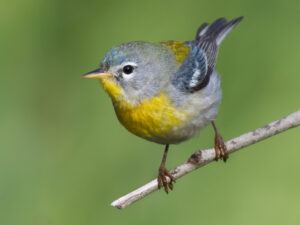
Males are blue on the hood and shoulders. Back green. Yellow throat and breast with a dark red spot mid-chest. Broken white eye ring. Two wide white wing bars.
Females are similar, but paler.
They are found along streams and in swampy forests with willows, maples, birches, hemlocks and other trees.
Northern Parulas are summer residents throughout North Carolina.
Cedar Waxwing
These crested birds with yellow band on the end of the tail are often found in flocks. They eat flying insects in summer, fruit and berries the rest of the year.
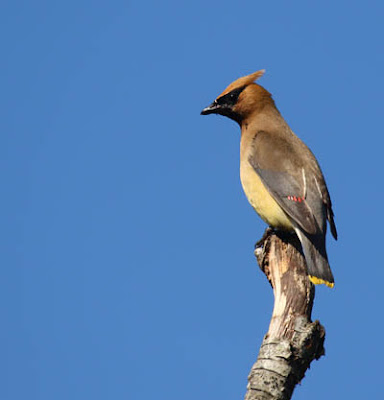 |
| Cedar Waxwing. Greg Gillson. |
These birds are fawn-brown above, with dark gray wings and tail. They have a black mask and wispy crest. The belly is yellow. The wings have waxy red drops on the end of the tertials. The end of the tail has a brilliant yellow tail band.
They are found in open habitats with berries, including juniper woodlands and towns in winter.
Cedar Waxwings are winter visitors throughout North Carolina, year-round residents in the mountains of western North Carolina.
Eastern Meadowlark
These pale brown birds with the brilliant yellow breasts are home on the ground in prairies. They sing from perches on isolated trees, power poles, fence posts.
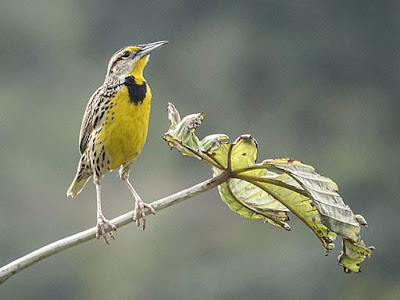 |
|
Eastern Meadowlark
Photo by Mike’s Birds from Riverside, CA, US [CC BY-SA 2.0]
|
The upper parts are streaked black, white, brown, so they blend into the dried grass where they live. The under parts are bright yellow with a black necklace across the chest. Very similar to Western Meadowlark, best told apart by spring song.
These birds live in prairies and extensive pasture lands.
Eastern Meadowlarks are year-round residents throughout North Carolina.
Pine Siskin
These small brown-streaked birds are relatives of the goldfinches. But you would never know it until they fly and sport yellow wing stripes and tail base. Usually in flocks.
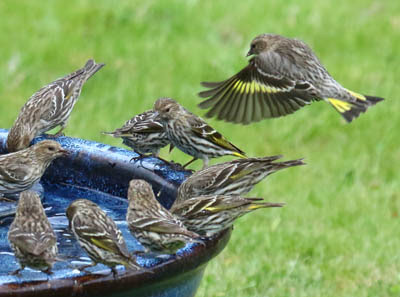 |
| Pine Siskin. Greg Gillson. |
These birds are streaked brown. In flight they have a yellow stripe down the length of the wing. The sides of the base of the tail is also yellow. Some birds are paler, some darker, others brighter yellow, others duller.
These birds are found in summer in northern conifer woods. Irregularly irrupt hundreds of miles southward. Frequent at feeders.
Pine Siskins are winter visitors throughout North Carolina.
Hooded Warbler
These birds are found low down in the forest understory. They flash white tail corners.
 |
| Male Hooded Warbler. Christopher O’Toole. Pixabay. |
Males are dark green above with a black cowl over the crown and onto the throat. Face and under parts are bright yellow. White tail corners.
Females are similar, but lack the black of the male. The crown is green and the throat yellow.
These birds are found in deciduous woods and swamps, primarily in brushy understory.
Hooded Warblers are summer residents throughout North Carolina.
Yellow-throated Warbler
These birds with the bright yellow throats creep along the branches high in trees.
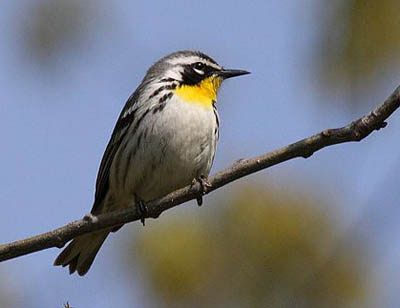 |
| Yellow-throated Warbler. Dominic Sherony. CC 2.0 |
These are rather gray warblers with bright yellow throat and upper breast. Black crown and face mask with white patch behind. White eyebrow. Two broad white wing bars. Black streaks on white breast and belly.
They like pine-oak woodlands, sycamores, cypress.
Yellow-throated Warblers are summer residents throughout North Carolina.
Wrapping Up
North Carolina boasts its fair share of stunningly colorful birds. While I have focused on the red, orange and yellow ones, there are many other colored birds to be found here. This is my list of the best:
Cerulean Warbler: Stunning males with vibrant turquoise bodies and black face masks, found in high canopy deciduous forests, delivering sweet, warbling songs.
Common Grackle: Greenish-black bodies with iridescent purple heads, often seen in large flocks foraging on fields and lawns, uttering metallic, clinking calls.
Eastern Bluebird: Dazzling males with bright blue upperparts, rusty chests, and white bellies, found in open fields and woodlands, singing charming, whistled songs.
Indigo Bunting: Striking blue bodies with black faces and white wingbars, males singing high-pitched, buzzing songs from perches in fields and shrubby areas.
Blue-gray Gnatcatcher: Tiny birds with blue-gray upperparts and white underparts, flitting through trees and low shrubs, uttering thin, high-pitched “zeet” calls.
Frequently Asked Questions
What kind of bird has a red belly in North Carolina?
There are several bird species in North Carolina with a red belly, so it’s important to consider other characteristics to narrow down the possibilities. Here are a few options with varying levels of red on their bellies:
Bright Red Belly:
Red-bellied Woodpecker: The most likely candidate due to its name and common occurrence in North Carolina. They have a black and white barred back, red head, and a noticeable patch of bright red feathers on their lower belly.
Less Distinct Red:
Northern Cardinal: Males have a vibrant red body, including the belly, which may appear slightly less intense in some lighting. Females are brown with a reddish wash or streaks on their chest and belly.
Summer Tanager: Males have a vibrant red body, including the belly, similar to cardinals but with a larger head and thicker bill. Females are yellowish-green with orange or yellow streaks on the chest and belly.
Scarlet Tanager: Males have a brilliant red body, including the belly, but they are primarily found in mountainous regions of North Carolina, especially during breeding season.
Western Tanager: Similar to the Scarlet Tanager but with a yellow head and throat, making the red belly less prominent. This species is a rare vagrant in North Carolina.
What is the difference between a towhee and an oriole?
Towhees and orioles, despite sharing some superficial similarities like splashes of orange and a fondness for fruit, are actually quite different birds from distinct families! Here’s a breakdown of their key differences:
Appearance:
- Towhee:
- Stockier build with a shorter tail compared to the slender oriole.
- Males have a black head and throat, rufous sides, and white underparts. The orange on their chest is limited and more muted, like a robin’s chest.
- Females are brown with rufous streaks and lack the bold black and white head pattern.
- Oriole:
- Slender and graceful with a long, forked tail.
- Males are typically a vibrant orange-black combination, with black heads and backs and bright orange underparts.
- Females are usually greenish-yellow with some orange highlights.
Habitat:
- Towhee: Prefer ground-dwelling, often found in dense vegetation, brushy fields, and forest edges. They scratch on the ground like sparrows to forage for seeds and insects.
- Oriole: Primarily arboreal, spending most of their time high in trees. They forage for fruit, insects, and nectar, often hanging upside down from branches.
Where can I see the Yellow Warbler in North Carolina?
Your chances of spotting a Yellow Warbler in North Carolina depend on the time of year, as they are Neotropical migratory birds. Here’s a breakdown of where to find them throughout the year:
Spring (April-May):
- Primetime! Yellow Warblers migrate through North Carolina on their way to their breeding grounds further north. Look for them in a variety of habitats, including:
- Wooded swamps and bogs: Their preferred nesting sites.
- Moist forests with willows and alders.
- Floodplains and riparian areas.
- Backyards with large trees and shrubs.
- Parks and gardens with dense vegetation.
Summer (June-July):
- Less common: After breeding elsewhere, some Yellow Warblers may linger in North Carolina. Check the same habitats as in spring, with a focus on higher elevations in the mountains.
Fall (August-September):
- Another good chance! Yellow Warblers migrate back through North Carolina on their way south. Again, look for them in similar habitats as in spring, especially near water sources.
Winter (October-March):
- Highly unlikely: Yellow Warblers spend the winter in Central and South America. You may hear sporadic reports of individuals overwintering in coastal areas, but sightings are extremely rare.
Related Articles:
See photos and learn about the most common backyard birds in North Carolina, regardless of color.
See photos and learn what to feed winter birds in North Carolina.
Here’s a quick tutorial of how I would teach you to identify birds: 7 Steps to Identify Birds!
Birds with red heads in North America.
Yellow-and-black birds in North America.
Little Brown Birds at your Feeder.



